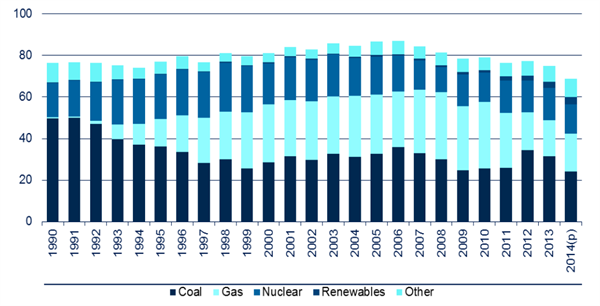
Large fall in UK emissions in 2014, official figures confirm
Simon Evans
03.26.15Simon Evans
26.03.2015 | 11:00amUK carbon dioxide emissions fell by 9.7% in 2014 year-on-year, according to official figures from the Department for Energy and Climate Change (DECC).
The provisional figures, published today, confirm Carbon Brief’s estimate published on 4 March of a 9.2% reduction, as the table below shows.

Source: DECC emissions data and Carbon Brief analysis of DECC energy data
A 23% reduction in coal use and record warm temperatures were the main contributors to the decline in emissions. Continued falls in energy use were also a factor.
Record fall for a growing economy
The carbon dioxide reduction is the largest on record for a growing UK economy. There were larger drops in 1893, 1921, 1926 and 2009, but GDP was falling, as the table below shows. The very large emissions cuts during 1921 and 1926 were followed by even larger increases, of 34% and 89% in 1922 and 1927.

The top six years for annual UK carbon emissions reductions, in records going back to 1880. Annual changes in UK GDP are shown for comparison. Source: emissions data from the World Resources Institute and economic data from the Bank of England.
Sustained, multi-year emissions reductions of more than 5% per year without economic recession are considered extremely unusual. The most commonly cited example is France, which cut its emissions by 5% every year for five years, at the height of its shift towards nuclear power.
Separately, provisional International Energy Agency estimates, reported by the Financial Times on 12 March, suggest global carbon dioxide emissions stalled in 2014. If confirmed, it would be the first time in 40 years when a growing global economy was not accompanied by rising emissions.
The 9.7% carbon reduction leaves UK emissions 29% below 1990 levels, at 422 million tonnes. Total UK greenhouse gas emissions also fell in 2014, the DECC figures show, with a slightly smaller 8.4% reduction compared to a year earlier.
Estimated 2014 UK greenhouse gas emissions of 520.5 million tonnes of carbon dioxide equivalent would be 36% below 1990 levels. The UK is aiming to halve its emissions by 2025 and cut them by 80% by 2050, both against 1990 levels. Today’s figures suggest the UK has met an interim target to cut emissions in 2020 by at least 34%, six years early.
Coal use down by a fifth
Falling coal use for electricity generation was the main factor in the 2014 reduction in UK carbon emissions, with a 23% year-on-year reduction. UK coal use for electricity generation is now below half that in 1990 (darkest blue chunks, below).

Sources of UK electricity generation measured in millions of tonnes of oil equivalent. Source: DECC statistical release.
In fact, total UK coal use in 2014 was the lowest seen since the 1850s, when the UK was in the midst of the industrial revolution. The reduction was caused by several factors. First, the unexpected closure of Ironbridge and Ferrybridge power plants last year following fires.
Second, the UK’s largest power station Drax switched more of its capacity to biomass during 2014, with one-third of its four-gigawatt capacity now using biomass instead of coal. This switch is part of the UK’s drive to decarbonise, which saw renewables grow to a 15% share of UK electricity generation during 2014.
The third and most decisive factor is changes in the relative price of coal- versus gas-fired electricity. Carbon Brief published a more detailed discussion of price effects in January.
UK gas use and emissions fell in 2014 despite an 8% increase in gas-fired electricity. This reduction was driven by last year being the UK’s hottest on record. As a result, homes and businesses needed less gas for heating, which accounts for half of UK gas use.
Transport emissions increased a small amount in 2014, with a 1% increase on 2013.
UK energy demand keeps falling
Another reason for falling UK emissions is continued reductions in energy demand, down 10% between 1990 and 2014. UK energy demand peaked in around 2005 and has been falling ever since.
A similar picture is being repeated across the EU, where energy use has fallen back to 1990 levels despite a 6% increase in population and a 45% expansion of economic output.
These falling energy use trends are a result of the installation of building insulation, improvements in product energy efficiency, uptake of renewables, vehicle fuel efficiency standards and changes in the structure of the economy.
Official figures published last week suggest UK emissions have fallen since 1990 even if you include emissions embedded in imported goods.

